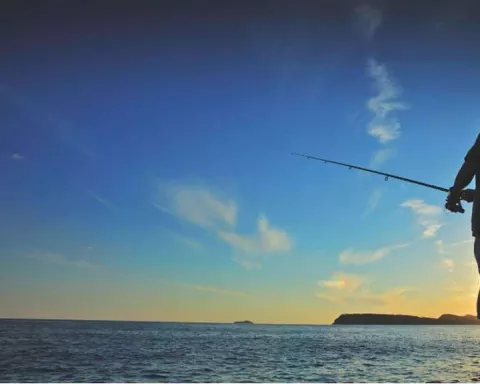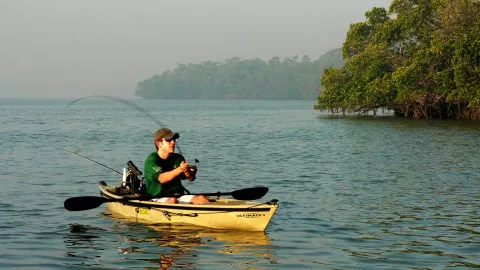Fishing the Ten Thousand Islands

From backcountry to kayak, fly fishing to light tackle, Florida’s Ten Thousand Islands in the western Everglades is an angler’s paradise.
The state of Florida, with its vast coastlines, wonderful climate and impressive fisheries, is undoubtedly the Fishing Capital of the World. The pinnacle of this fishing paradise is south of Chokoloskee Island in the Ten Thousand Islands section of Everglades National Park. The area is rich in history, angling opportunities, diversity and experience.
Chokoloskee Island & the Western Everglades
Located only 90 minutes from Miami, Fort Lauderdale and Fort Myers, and within 40 minutes of nearby Naples and Marco Island, few places rival the western Everglades. It's a massive nursery of marine life that feeds an array of sport and food fish. From its rivers, flats and islands spills the forage that nurtures the species that we sportsmen seek – bass, tarpon, snook, redfish, trout, permit, cobia, shark, grouper, snapper, pompano, sheepshead, triple tail, mackerel and kingfish. It's common to catch a dozen or more species in a single trip.
Located in the approximate geographic center is the gateway to this paradise, Chokoloskee Island. Chokoloskee is a 137-acre island, rich with history, on the southern side of the Ten Thousand Islands area. To the northwest are literally thousands of mangrove islands to fish. Against the mainland's southern shore, the waters of the tidal rivers have been flowing in and out of the backcountry since long before we were around. These rivers provide excellent opportunities to fish oyster bars, sand and mud flats, scoured holes, river mouths, run-offs and feeder creeks.
Fishing the Backcountry Tidal Rivers
While artificial fishermen and live baiters alike can fish these rivers effectively, this is perhaps the fly fisherman's paradise. The "head waters" are crystal clear, though always tea-colored from the tannic acid released by the mangroves, providing excellent sight-fishing opportunities.
The rivers are littered with small mangrove islands and feeder creeks that are havens for fish, such as the "resident" populations of small tarpon. The moving water scours deep "holes" and at the same time creates sand and mud flats. Numerous oyster bars – nature's little fortresses for crabs, shrimp and small fishes – are up and down the river, creating natural rips and eddies.

North of Chokoloskee lay the Pumpkin, Little Wood, Wood, East, Fakahatchee, Ferguson, Barron and Turner rivers. South you will find the Lopez, Chatham, Houston, Lostman's, Rodgers, Broad and Harney rivers, as well as many unnamed creeks large enough to hold tarpon, snook, redfish, grouper and more. No matter which river or tributary you explore, there are more excellent fishing spots that you could possibly try in a day.
The north rivers dump into large bays surrounded by thousands of islands. Each provides opportunities for fishing its respective oyster bars, cuts, mangrove overhangs and rips. The islands themselves form massive "passes" that tidal waters flow through. These passes scour holes that are sometimes over 20 feet deep. The smaller of the groupers, the largest of the black drum, Spanish mackerel and the cobia move into the passes in the cooler months. As things warm up, the massive goliath groupers, large numbers of large tarpon and the biggest of the snook move in. Snapper, jack, trout, pompano and ladyfish are a given almost year-round.
No matter which river or tributary you explore, there are more excellent fishing spots that you could possibly try in a day.
The south rivers are fed by the backcountry, a vast flooded area of saltwater bays, bayous, bights and islands. Part of this country is the Wilderness Waterway, a marked boating trail maintained by Everglades National Park that runs for 99 miles all the way to Flamingo.
Higher in the backcountry, to the north, above the bays, are runoff creeks from the mainland. Here you can catch a snook in one cast, redfish the next and a large mouth bass on another.
The south river mouths are defined by massive oyster bars and passes that cut through even larger grass and mud flats. At the proper time, these areas concentrate large numbers of fish and wildlife. Fishing the mouths, it is common to be amongst hundreds of wading birds, manatee, alligators, dolphin, eagles and osprey. You will even see deer, pigs, cats and bear on the beaches.
Barrier Island Fishing: Sight-Fishing at its Finest
The outside barrier islands both north and south are lined with pristine, isolated beaches with grass flats just off the shoreline. Snook, redfish, shark and jack roam these waters, making for excellent sight-fishing opportunities. Trout, pompano, ladyfish, flounder and redfish are up on the flats. Tarpon, shark, cobia, large jack and dolphin will be there, too, hunting the smaller species. While trout fishing with six to eight pound spinning gear, my anglers will almost always run into a school of ladyfish. In the spring, summer and fall, quite often a ladyfish will be gobbled up by a marauding tarpon.

Just offshore, within sight of land, are natural and artificial formations that hold piles of fish – cobia, snook, goliath groupers, mackerel, kingfish, snapper and permit. A typical day can consist of the inside/outside trip. Anglers get to fish "inside" amongst the rivers and islands in the morning and "outside" on the near-shore structure in the afternoon. In the warmer months, I often get to witness Mother Nature's food chain firsthand. At least once a week, I have an angler's cobia, permit or snook inhaled by a giant goliath grouper or run down by a shark. It certainly makes for an exciting day on the water!
Weather Always Permitting: Fishing Every Day in the Ten Thousand Islands
The typical angler can't always choose to fish when the weather is perfect. Most of us fish when other obligations allow, when we have time off or are on vacation. Unlike most every other fishery in Florida, rarely are you blown out because of weather in the western Everglades. Because of the diverse fishing opportunities and vast amount of sheltered water, you can almost always find good, sheltered areas to catch fish no matter what the weather guessers deliver.
One of the most attractive features of the area is the solitude.
For some, including me, one of the most attractive features of the area is the solitude. I prefer to fish alone with my anglers, the wildlife, the islands and the fish. I like feeling as if this special place and time is mine. Here you have that choice. It is very easy to get away from others because there is just so much country available to explore and experience.
I feel very lucky to be able to live and work in this area. One of my greatest thrills is watching people experience the Ten Thousand Island for the first time. The look on an angler's face as he looks down at his reel to see the bottom of the spool appear as a permit streaks to the horizon, or the excitement in a youngster's face when she sees a snook break the water, is absolutely priceless. I would not trade it for anything in the world.
Capt. Charles Wright runs Chokoloskee Charters and www.EvergladesKayakFishing.com. With four different boats to choose from and a fleet of outfitted fishing kayaks, he is able to allow his anglers to experience all the fishing opportunities the area has to offer.
Explore More of Paradise Coast

Driven by Passion: Kazuki Furusawa and the GT-R Legacy in Paradise

Driving It Forward: Tom O’Riordan on Cars on 5th and the Naples Automotive Experience

Top Scenic Drives on Florida’s Paradise Coast for Car Lovers

Inside the Naples Car Scene with Collector Pat Mullaney

Porsche Country: Porsche Collectors Lisa and John on Life in Naples
